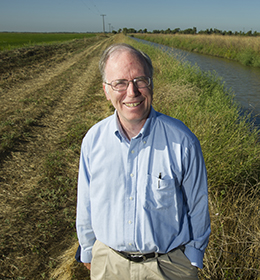Where would California be without the ability to store water? We talked to Jay Lund―an adjunct fellow at the PPIC Water Policy Center and director of the Center for Watershed Sciences at UC Davis—about the often contentious and always complex topic of water storage.
 PPIC: What should every Californian know about storing water?
PPIC: What should every Californian know about storing water?
Jay Lund: Thanks to our Mediterranean climate, California has a very long dry season, which is when we use most of our water, and a fairly short wet season, when we try to gather and store water. To put water storage in perspective, California every year has a worse drought–in the form of a long dry season—than most of the country has ever seen. California has always relied on water storage, and in droughts today we rely on it even more. Almost all the water people use in summer has been stored someplace—either in a reservoir or groundwater. The state’s natural storage system of groundwater and snowpack is now augmented with reservoirs, pipelines, and groundwater pumping. This storage and conveyance system has been critical to California’s prosperity, particularly to its agricultural economy.
You often hear calls for more storage, and of course we do have some limitations in water storage capacity. But no matter how large a reservoir you build, you’ll never be able to reliably get more water out than that stream’s average flow into it. In much of the state the problem is that there’s not enough water available to store or that we can’t get water to the places where it’s needed most. The bottlenecks are often inadequate conveyance rather than storage.
PPIC: What did we learn about water storage from the recent drought and subsequent record-breaking wet winter?
JL: The drought highlighted the importance of groundwater storage. Surface storage in reservoirs is very important in the first couple years of a drought, but with longer droughts we rely more and more on groundwater storage. Groundwater will always be our primary storage for long droughts. California has 400–500 million acre-feet in groundwater storage, compared to about 42 million acre-feet in total surface reservoir capacity. Water quality is a bigger challenge with groundwater than with surface water, since pollutants can be washed into aquifers and accumulate there.
California’s geography is fortunate—we have huge aquifers under the Central Valley. Farmers made up for about 70% of reduced water supply during the drought by pumping groundwater. The longer the drought, the more important groundwater becomes. If we don’t manage to recharge enough water during wet years, there won’t be enough in drought years.
The wet year brought us the Oroville Dam spillway crisis. All of the dam’s outlet structures were compromised or broken for much of the winter. It was a good reminder that we have to maintain these structures and systems, and find funding for maintenance and independent inspections. Good inspectors will always find some concerns and problems, but few problems rise to the level of crisis. With California’s extensive water infrastructure system, if you’re not finding any problems you’re not looking hard enough.
PPIC: What will it take to made good use of groundwater recharge and storage?
JL: You need three things to recharge groundwater: porous land above an aquifer, enough water available above that land, and enough empty space under that land to store it. While local conditions are important, the big limitation for the areas of California experiencing groundwater problems is lack of surface water available for recharge. During this wet winter, people were trying to recharge as much as possible and being very creative about it. But this was a record wet year. We often lack enough water to get good recharge.
To improve recharge locally, we need a better accounting system to improve incentives. We also need more legal protections for local agencies that want to do recharge, and faster authorizations to recharge in wetter years.
Read “Expanding Water Storage Capacity in California” (California Water Blog, February 22, 2012).
Visit the PPIC Water Policy Center.


